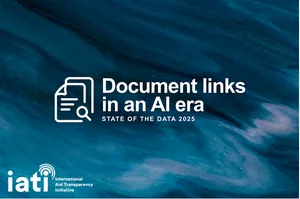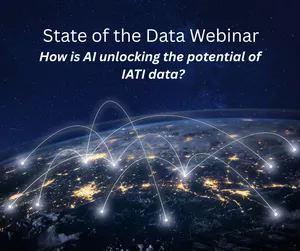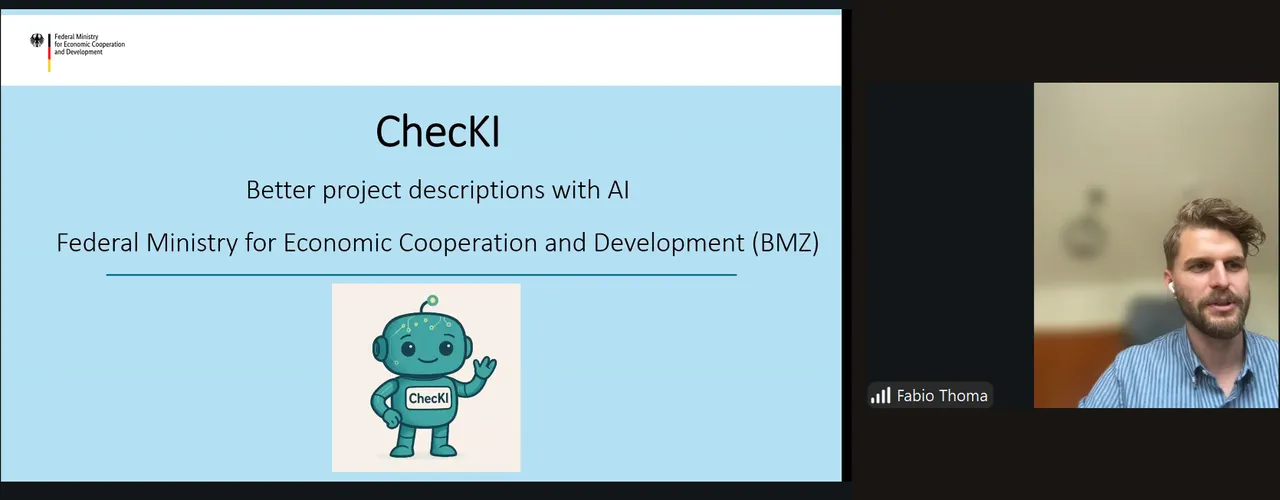What happened at IATI’s First ‘State of the Data’ Dialogues?

IATI’s new State of the Data series launched this month with a deep dive into nearly half a million documents linked to the IATI Standard.
Across two interactive webinars, IATI’s community explored how linked documents and the rise of artificial intelligence are reshaping the possibilities of development transparency.
Webinar 1: Document Links in an AI Era
During Webinar 1 (8 July), the IATI Secretariat presented its new interactive analysis: Document Links in an AI Era, exploring how documents linked through the IATI Standard provide critical context to development and humanitarian activities.
“Document links might sound simple—just a way to reference a budget, an evaluation, or a contract. But as this analysis shows, they are critical connective tissue in the information ecosystem.” — IATI Executive Director Yemesrach Workie
Introducing the State of the Data Community Dialogues, IATI Executive Director Yemesrach Workie said: “Document links might sound simple—just a way to reference a budget, an evaluation, or a contract. But as this analysis shows, they are critical connective tissue in the information ecosystem.”
The session revealed:
- 441,986 unique documents are linked by 929 organisations
- Budgets are the most frequently linked category (150,000+), followed by results and objectives
- 57.9% of all documents are PDFs, with the remainder mostly in HTML
This unstructured data is a gold mine of information that is essential to understanding the why, how, and impact behind aid flows.
The first State of the Data Community Dialogue generated a wealth of questions and insights, highlighting strong interest from the IATI community in the analysis and improving the data. Key questions and themes that emerged include:
- Whether it's time to review and update IATI’s document-link categories, which have remained unchanged since version 1 of the Standard (launched in 2011).
- Opportunities to improve guidance and metadata around linked documents, drawing on lessons from partners like Publish What You Fund.
- The potential to use AI to extract richer metadata from documents, such as dates, countries, summaries and organisations.
- Community questions on whether IATI should develop services for storing, caching, analysing, or enriching documents, and what resourcing or licensing issues this would raise.
Share your thoughts post-webinar on IATI Connect: Webinar 1 Discussion Points #1 and Discussion Points #2

Webinar 2: How AI is unlocking IATI data
Webinar 2 (15 July) showcased three live demonstrations from organisations putting IATI data and documents to work through artificial intelligence:
- BMZ’s ChecKI Tool: Germany’s Federal Ministry for Economic Cooperation and Development (BMZ) shared an AI-powered tool that provides feedback on the quality of project descriptions. ChecKI helps strengthen free-text data, highlighting its value for human understanding and AI applications alike - and supports development professionals in producing higher-quality IATI data.

- AidInsights: This new platform allows users to ask natural-language questions about IATI data, such as “Who is funding solar projects in India?”, and receive intuitive, visual answers. The tool opens up IATI to a wider audience by removing technical barriers to data access and exploration.
Funded by the UK Foreign, Commonwealth and Development Office, DevExplorer uses large language models to analyse linked documents and summarise insights across portfolios.
- DevExplorer (FCDO Frontier Tech Hub): Funded by the UK Foreign, Commonwealth and Development Office, DevExplorer uses large language models to analyse linked documents and summarise insights across portfolios. In the demonstration, the tool generated narratives from document-linked data, synthesising lessons learned and key challenges from annual reviews and completion reports from water and sanitation (WASH) sector projects.
IATI is grateful to each organisation for presenting these cases, which help demonstrate the growing role of AI in making IATI data more accessible. Key reflections from all contributions made during the session include:
- Advocacy: IATI is well-placed to convene and lead conversations around AI in the sector, particular given the evidence that several development cooperation organisations have long engagement with the initiative over several years
- Technology: The IATI Standard is an excellent resource for those using AI tools and approaches, given the structured and standardised nature of any data. Going forward it would be helpful to explore how IATI can be embedded in new and emerging AI protocols.
- Engagement: The session surfaced many ideas and questions—showing there’s much more to explore, share and discuss around AI and IATI data.
Looking ahead
As IATI develops its Strategic Plan 2026–2030, insights from this first edition of the State of the Data series will help inform the initiative’s future thinking around harnessing emerging technologies, particularly AI to improve the publication and usability of development and humanitarian data.
The next analysis in the State of the Data series will be released in September and will focus on organisation references.
To ensure that funding, activities, and results can be followed across the development delivery chain, it is essential for organisations involved to be referenced consistently. The Secretariat will deliver analysis exploring how IATI publishers currently reference organisations they work with, and what this means for linking information across systems.
The State of the Data series will feed into a State of the Data Review, to be published at the end of 2025. This report will bring together insights from the year’s analyses, as well as other key discussions on the usefulness of IATI data.
Stay involved
- Explore the analysis: Document Links in an AI Era
- Join the conversation: Comment and contribute on IATI Connect
- Watch the recordings: Webinar 1 /Webinar 2